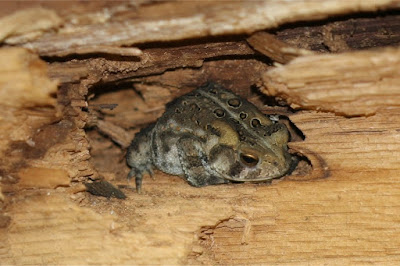On a cloudy summer day I explored the new Logan Hill Preserve with my ThermApp. Much like a typical outing in the woods with a thermal camera, you quickly run across a squirrel or a chipmunk:
Shortly thereafter, the camera found this much larger hotspot high in a distant tree:
It's hard to tell for sure, but it looks like a raccoon:
Here's another view of that same probable raccoon:
There were certainly other raccoons in those woods, as I soon had this guy come traipsing down a log, seemingly unaware of my presence.
Anytime you're in a forest with cavitied trees and a healthy population of rodents, you come across warm spots like this:
I have no idea what's in there, but that space between the bark and the trunk of the dead tree certainly looks like a good resting spot for some critter.
Here's another such warm spot in a fallen tree:
Bringing up my binoculars, I saw a strange face staring back at me, so I got closer:
Can you tell what it is from that thermal image?
When using my ThermApp to seek out wildlife, I'm always looking for warm spots, because those are what stand out against the background. But in this case, the face staring back at me was a toad, and it is colder, not warmer, than the surrounding. (More precisely, it is approximately the same temperature as the surrounding, being "cold-blooded" and all.)
So I guess it was just a coincidence that while investigating a warm spot in a tree I happened to locate this cold-blooded animal instead. Or, you could also conclude that that toad decided to hang out in that cubby precisely because it is slightly warmer than its surroundings! Meanwhile, the source of that warmth, either some critter deeper inside that log, or perhaps just wood rot, remains unknown.
Shortly thereafter, the camera found this much larger hotspot high in a distant tree:
It's hard to tell for sure, but it looks like a raccoon:
Here's another view of that same probable raccoon:
There were certainly other raccoons in those woods, as I soon had this guy come traipsing down a log, seemingly unaware of my presence.
Anytime you're in a forest with cavitied trees and a healthy population of rodents, you come across warm spots like this:
I have no idea what's in there, but that space between the bark and the trunk of the dead tree certainly looks like a good resting spot for some critter.
Here's another such warm spot in a fallen tree:
Bringing up my binoculars, I saw a strange face staring back at me, so I got closer:
Can you tell what it is from that thermal image?
When using my ThermApp to seek out wildlife, I'm always looking for warm spots, because those are what stand out against the background. But in this case, the face staring back at me was a toad, and it is colder, not warmer, than the surrounding. (More precisely, it is approximately the same temperature as the surrounding, being "cold-blooded" and all.)
So I guess it was just a coincidence that while investigating a warm spot in a tree I happened to locate this cold-blooded animal instead. Or, you could also conclude that that toad decided to hang out in that cubby precisely because it is slightly warmer than its surroundings! Meanwhile, the source of that warmth, either some critter deeper inside that log, or perhaps just wood rot, remains unknown.











Hi! I am a bird bander from sweden and is thinking of buying the therm-app. My plan is to use it to find birds nests and those hard to find chicks of plovers and lapwings. Do you think the therm-app will do the trick? Can it detect a baby bird the size of a golf ball 15-20 meters away?
ReplyDeleteYes, a golf-ball-sized bird 20m away can be detected with the default 19mm lens. Better with the expensive 35mm lens, of course, but the 19mm should be good enough.
DeleteThings to be aware of are (1) it still requires line-of-sight, so if the bird is behind grass or in a hole, it won't be seen; (2) rock and sand can be warm after exposure to the sun, so on a sunny day, a plover will probably not stick out if it's on sand or rock. (I actually haven't tried my ThermApp at the beach.) Wood (sticks and branches) will also be warm when sunny, but leaves (including grasses) tend to stay cool. Seed pods (like thistles) can also get warm in the sun.
Thank you! My plan is to try to find the plovers in the early dawn. There are no grass and mostly just sand and gravel in the area. It should work fine then!
DeleteI think this is the best blog I have been through all this day.
ReplyDeleteHP Thermal Camera
This is such an informative post. You have a lot of really great points. I wish I had this post as a resource when I started blogging.
ReplyDeletebird Watching Binoculars.
Wow. The love of birds with application of technology has extended the human senses. Great reading your posts Suan. Appreciate your sharing. Subramanian Sankar Chennai, India
ReplyDeleteThis comment has been removed by a blog administrator.
ReplyDelete